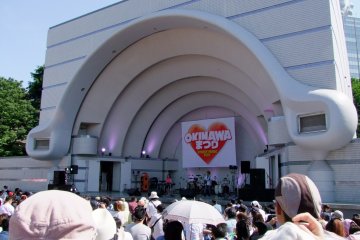
Festival de Okinawa en el Parque Yoyogi 2026
Todd WojnowskiCaptura el espíritu veraniego de Okinawa en medio del concurrido parque Yoyogi de Tokio, en el festival de Okinawa, celebrado cada año.

Como uno de los espacios verdes más grandes de Tokio, el Parque Yoyogi es un imán para los residentes de Tokio que quieren disfrutar del sol y la naturaleza o que quieren asistir a uno de los numerosos festivales que tienen lugar en el parque durante todo el año.
Aunque el parque Yoyogi tiene relativamente pocos cerezos en comparación con otros parques en Tokio, es un hermoso punto de vista para los cerezos en flor en primavera. También es conocido por sus árboles ginko, que se vuelven dorados en otoño.
Antes de que el parque se convirtiera en un parque de la ciudad en 1967, el área fue el sitio de la Villa Olímpica para los Juegos Olímpicos de 1964. El Parque Yoyogi está justo al lado del Santuario Meiji.
Tokyo Metro Chiyoda line: Yoyogi Koen (Exit 3 or 4) or Meiji-jingumae/Harajuku Station (Exit 2) JR Yamanote line: Meiji-jingumae/Harajuku station (Omotesando Exit)

Captura el espíritu veraniego de Okinawa en medio del concurrido parque Yoyogi de Tokio, en el festival de Okinawa, celebrado cada año.
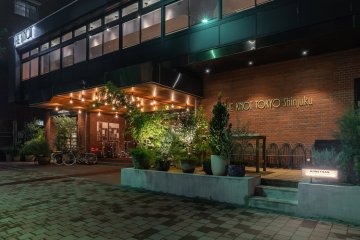
Ubicado justo al lado del gran parque central de Shinjuku, THE KNOT TOKYO Shinjuku es un moderno hotel boutique con fácil acceso a la cercana estación de Shinjuku y al santuario Meiji. El edificio del hotel de 14 pisos fue renovado y reabierto en agosto de 2018 como THE KNOT TOKYO Shinjuku . Cuenta con más de 400 habitaciones y 7 tipos de habitaciones distintas, todas cuentan con un estilo occidental y ofrecen vistas al parque desde el piso superior, así como una terraza suite recién inaugurada. El amplio diseño del atrio ofrece un ambiente relajado y conecta el restaurante, el bar, el salón y el vestíbulo. Una de las mejores amenidades del hotel THE KNOT son los deliciosos platillos que ofrece. Cuenta con seis áreas distintas donde se ofrecen comidas y bebidas a sus huespedes o visitas. Desde el área de parrilla hasta té negro de alta calidad y pan recién hecho.

With Koenji being a "creative town" it's no surprise that the BnA Hotel opened there in 2016 and has had, subsequently, an incredible impact on the local community. BnA (Bed and Art) has other spaces dotted about Tokyo and Kyoto, but the Koenji edition is possibly more immersive as the concept is "stay in an artwork." In collaboration with local artists, the BnA has created an impressive multi-storey art experiment for art lovers and creatives with a desire to inhabit art. The first floor acts as a front desk and bar which comes alive at night with events and selected DJs. It also hosts Masu Masu onigiri cafe with artists being asked to come and exchange artwork with each other in a gesture which reflects the true spirit of Koenji. With two "living art" twin rooms taking up the second and third floors designed by a seasonal rotation of local artists, guests can engage with and inhabit their art rooms. BnA Koenji also plays host to a rooftop lounge and a basement space which is used for artists residencies where their work is shown to the public and a DJ booth and streaming equipment for live performances. With live painting events and an eclectic variety of regular events, the BnA Hotel becomes, itself, a living canvas. The BnA believes that it's a machigata hotel, meaning that guests should (and are encouraged) to interact with Koenji. Use the public sentos, eat in the local restaurants that surround the hotel and buy locally from the multitude of shops, market stalls, bars and cafes which make-up the fabric of Koenji. Feted by international press such as The Guardian, BnA acts as a creative network with the concept of serendipity being discussed as the bar becomes an ad hoc meeting place where collaborations and friendships between artists and locals are born. The BnA was also instrumental in a street art festival named MCP (Mural City Project) which was supported by Suginami Ward. MCP was incredibly ambitious and truly communal with the desire to transform and coalesce the community through the creation of public murals. The BnA, Koenji and Suginami spearheaded a public art movement which should be commended and replicated throughout Tokyo.
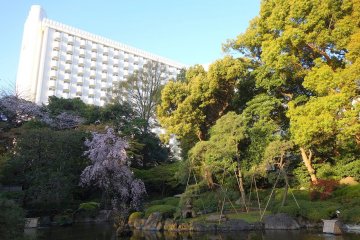
Just minutes from Shinagawa Station, the Grand Prince Hotel New Takanawa is surrounded by lush greenery in the Takanawa area, with rooms offering balcony views of the nearby gardens and the surrounding Tokyo cityscape. This urban resort features convention facilities like the Hiten banquet hall, the international Convention Center Pamir, as well as a wide variety of Japanese, Chinese and Western restaurants.

Mame Shiba Cafe offers a unique experience where you can interact with Shiba dogs while enjoying your favorite drinks. You cannot make reservations in advance through phone or online, so it is best to book early in the morning at a store. The cafe requires customers to make a reservation in-store, present their receipt at the reserved time, and then enter the cafe.

B-Flat Commune is an open-air hangout in Omotesandō featuring a variety of stalls and food trucks offering unique drinks, clothing, and bites to eat. Its relaxed vibe and plenty of seating make it an ideal spot for casual meetups and spending time with friends. It's a creative place where people can gather to eat a the open-air dining space or purchase fashion, antiques, product goods and other lifestyle items. Events are sometimes hosted at this community space, and operating stores may change from month to month.

If you're a fan of Quentin Tarantino’s Kill Bill, there's one Tokyo restaurant that absolutely deserves a spot on your bucket list. While you may not know it by its real name, chances are you've seen it on screen—it’s the unforgettable setting for the iconic, over-the-top showdown between The Bride and the Crazy 88. Known affectionately by fans as “The Kill Bill Restaurant,” this venue offers more than just cinematic nostalgia—it's a vibrant and unique dining experience in its own right. Located in Tokyo’s upscale Nishi-Azabu district, this classic-style izakaya bar is where fiction meets flavor. Though the fake blood and samurai swords have long been cleaned away, the spirit of the film lives on in the architecture and atmosphere. Stepping inside feels like walking onto the set: a grand, high-ceilinged hall with a central open-plan dining space, surrounded by a mezzanine-level balcony—instantly recognizable to anyone who’s watched the movie. But don’t mistake it for just a movie-themed attraction. The Kill Bill restaurant is a serious culinary destination. It offers a wide variety of traditional Japanese dishes, from sashimi and grilled skewers to noodle dishes and seasonal specialties. The menu also boasts creative fusion items like avocado and camembert tempura, which nods to the restaurant’s global popularity and mindset. And for international travelers with specific dietary needs, the restaurant provides vegan and halal-friendly menus (with at least three days’ notice). What makes this spot truly special is its ability to deliver a top-tier gourmet experience while doubling as a pop culture pilgrimage. You can sip sake where Uma Thurman once sliced through waves of enemies—minus the chaos, of course. Whether you’re a die-hard Tarantino fan, a foodie on the hunt for authentic Japanese flavors, or simply someone looking for a unique night out in Tokyo, this restaurant checks every box. Just one tip: Enjoy the drinks and dishes, but leave the swordplay to the professionals. Note: As you’d expect, Gonpachi is a popular restaurant. Same-day reservations are possible, but ideally you’ll want to reserve your table at least two days ahead of your visit, and even earlier if you’re planning to visit at the weekend.
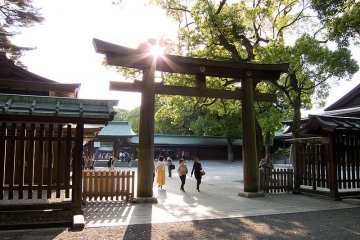
Aunque no se completó hasta 1920, el Santuario Meiji Jingu se ha convertido en uno de los lugares más populares para visitar en la capital japonesa. Tanto el santuario como el parque Yoyogi adyacente están justo al lado de la concurrida estación de Harajuku. Los aproximadamente 100.000 árboles que componen el bosque Meiji Jingu se plantaron durante la construcción del santuario y fueron donados por regiones de todo el país. El Santuario Meiji Jingu fue destruido durante la Segunda Guerra Mundial, pero reconstruido poco después. Está dedicado al emperador Meiji y su esposa, la emperatriz Shoken. Durante el período Meiji donde Japón se modernizó y occidentalizó. En los primeros días del Año Nuevo, el santuario recibe regularmente a más de tres millones de visitantes para las primeras oraciones del año (Hatsumode), más que cualquier otro santuario o templo del país. Durante el resto del año, a menudo se pueden ver bodas sintoístas tradicionales.
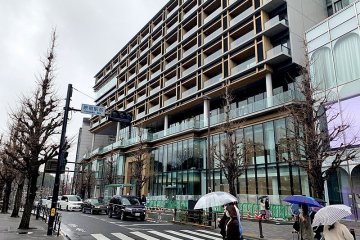
"With Harajuku", el nuevo complejo residencial y comercial en la glamurosa meca de la moda de Tokio, se encuentra directamente frente a la estación de Harajuku. En "With Harajuku" puedes participar activamente en las tendencias que cambian rápidamente en Tokio incluyendo una de las tiendas de ropa UNIQLO más grandes y una tienda nueva de la gran cadena de IKEA. Harajuku se refiere al área alrededor de la estación de Harajuku, que es el centro de las culturas y estilos de moda adolescentes más extremos de Japón. No muy lejos se encuentra el glamoroso distrito de Omotesando, donde las marcas de lujo internacionales se encuentran. El Takeshita Dori no está lejos de "With Harajuku", donde puede descubrir tiendas de moda, todo tipo de boutiques, al igual que tiendas de segunda mano, este es un lugar donde podrá lograr sumergirse en la cultura de la moda de Japón.
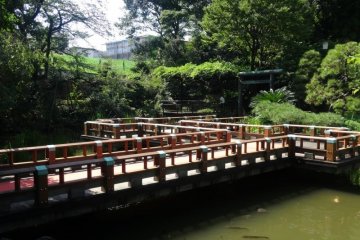
The Tōgō Shrine was established in 1940 and dedicated to Gensui The Marquis Tōgō Heihachirō shortly after his death. This shrine was destroyed by the Bombing of Tokyo, but was rebuilt in 1964. It is located in Harajuku, Tokyo, Japan. There, The Marquis Tōgō Heihachirō is celebrated as a shinto kami. [Wikipedia]